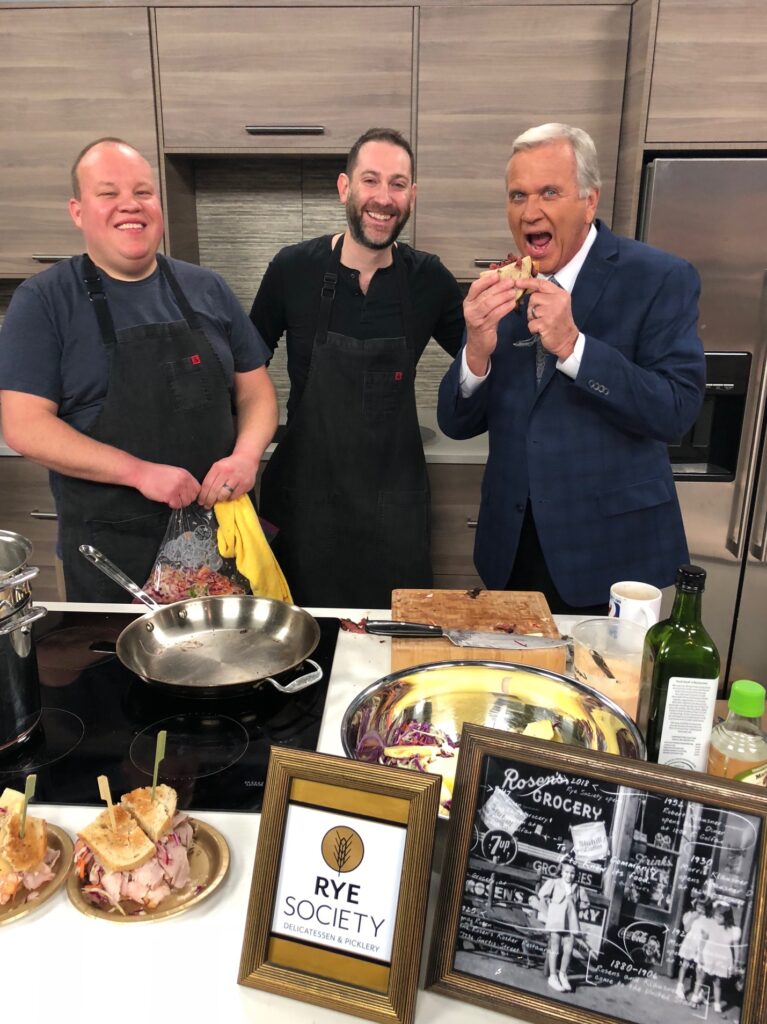We recently partnered with Colorado Proud to offer a six-part, FREE webinar series on marketing tips and tricks. Our first webinar, PR 101, inspired this blog post. To watch that webinar and for info on the remaining five webinars, click here.

Everyone’s heard of that one company that got a story in The New York Times or O Magazine and was instantly catapulted to financial success. While results like that tend to be the exception rather than the rule, you can still set your company up for success (and have a major advantage over your competitors!) by preparing for incoming media attention.
Much better still, you can take this to the next level by pursuing the types of stories and mentions that can give your company a major boost, achieving much more success while spending a lot less money than you would on other marketing tactics such as advertising.
However, it can be a little intimidating to be interviewed for an article that thousands of people will read. We’ve outlined some tips to make these opportunities your chance to shine, to promote your company and your offerings to a huge number of potential customers – for low to no cost.
In this blog, we’ll also discuss the current media landscape, and cover the basics such as figuring out what is “newsworthy”, how best to tell your story, creating relationships that last, and how to leverage those big media hits once they start coming in.
What is PR exactly?
“Public relations (PR) is the practice of deliberately managing the release and spread of information between an individual or an organization and the public, in order to affect the public perception.” (-Wikipedia)
Essentially, it’s managing your reputation – your relationship with the public.
What we love about PR: it’s real. It’s authentic. Public relations is telling your true story. It’s not about “spin”, which “implies disingenuous, deceptive and/or manipulative tactics.” PR is all about building and maintaining relationships, and the most successful PR efforts are based on trust.
Successful PR is often achieved through a third-party endorsement (unpaid), reaching the public through the media (“media relations,”) or through influencers like bloggers and Instagrammers (“influencer marketing”.) And these days with SO many options and so much information out there, buyers are increasingly relying on trusted experts to cut through all the noise and tell them what to buy.
Not all PR is a third-party endorsement, but we are focussing on media relations in this blog post. You can also improve your company’s reputation by communicating with your customers and potential customers directly, through channels such as email, blogs, social media (read this blog and this one,) partnerships and other types of content marketing.

Advertising vs PR
Advertising is you paying someone else to say that your company is awesome. PR is you sharing your offerings with a trusted expert, and those experts telling their readers and followers that you are awesome (which even if you’re paying a PR agency like ROOT to do that for you, is almost always less expensive.) Plus, PR is much more effective because it’s much more believable, and all the advertising in the world cannot compensate for unfavorable PR.
Media today
Newsrooms have been shrinking for years, but most dramatically since COVID hit. With advertising dollars decreasing even more this past year, many of the media who do still have their jobs are in fear of losing them. They’re covering many beats and expected to be experts on all kinds of subjects.
What can you do to maximize your chances for success?
Be prepared
First, take a few steps to get ready. You’ll need these tools whether you’re actively pursuing media attention, or just want to be ready in case your local newspaper calls.
Create a media kit
Here are the parts you need for your media kit:
- ABOUT US (story of the company)
- WHO WE ARE (bios and headshots of the key players)
- ART”: professionally-taken, high resolution photos that illustrate the story you want to tell, company logos, any videos you have
Create a MEDIA INFO page
- Post these elements on your website on a page titled “MEDIA INFO” so the media can easily access this info whenever they want, and download the photos they want. (Pro Tip: Once you have news releases and/or media hits, you can post them here as well.)
- Add any awards you’ve received
- Add links to your social media channels, email newsletter sign up, etc.
- Here are a few examples that we have created for our clients: ORIGIN Milk, ChefReady, and Kyoto Botanicals.
Create your 4-6 key messages
When that writer calls to interview you, or they say “lights, camera and ACTION!” on TV, it can be really easy to panic and forget the most important things you really want to say! Be prepared by thinking through and memorizing your “key messages” (talking points). Ask yourself: if The New York Times called with only 5 minutes to interview you, what would you want to be sure to say? What makes your company special, what are your advantages over your competitors?
Once you’ve created these all-important key messages, check ALL of your marketing materials against them to make sure you’re conveying these powerful messages in everything you say (website, social media, etc.) Make sure to use them to write your newsletters, flyers, etc. For an example of some key messages, check out this doc.
Be proactive
Then, take things to the next level by going after the media and influencer attention you want:
- Create a media list: what are your customers reading, watching or seeing? Think big picture (e.g. trade outlets, food and lifestyles publications, etc.) Create a spreadsheet with contact info so you can keep track of your efforts.
- Figure out what your compelling stories are: with those media outlets in mind, brainstorm possible story angles. What is your news, and/or what can you do to create news-worthy stories?

Evergreen stories
The stories you can ALWAYS pitch include the history of your company (how did you get where you are today?); your strengths, particularly in comparison to your competitors; and your products and offerings.
WIIFM
However, the story angles that will garner you the most media attention are the ones that the most people will find interesting (noting that the reader, viewer or listener is always thinking “what’s in it for me?”) How does what you are doing or offering benefit people?
Now is news
If you add to that the other big story selling element of something that makes this timely, like new products, new product lines, or new talent; or has some kind of a deadline, you’re much more like to get coverage than if you’re simply stating that your company is doing what it always does. Can you create a story by coordinating some type of event that involves the public, like a contest, specials, non-profit partnerships, special events?
Plan it out
The tricky part about pitching time-sensitive story angles is getting them the information at just the right time. The next step is to figure out WHEN you will tell each of those stories, using a calendar and spreadsheet to get organized.
- “Short lead” publications are working on the stories they’re going to tell today, or in the next week or two, or next month. This includes outlets such as your local newspaper and TV channel, and many digital outlets, whether local, regional or national.
- “Medium leads” tend to work more like 2-3 months out. This can include media outlets that cover your entire state or the states around yours (e.g. Sunset Magazine.) No harm in sending short lead outlets your info 2-3 months out as well (although you may want to follow up with them again a few days/weeks in advance of the time-sensitive event to make sure you’re still top of mind.)
- “Long leads” are usually national magazine like Bon Appetit, etc., who are typically thinking about their issue that is 5-6 months away. Again, no harm in following up with them perhaps one month in advance to see if you can make it into their digital outlet, if they have one.

Go for it!
Ok, you’re ready! You know what you’re going to say, to whom, and when. You’ve got all the tools you need to feel confident and get them what they want when you’ve piqued their interest. Now – how do you communicate with them? Folks rarely call the media anymore, but do you send them an email (“pitch”,) a media alert, or a news release? And what are all those things anyway?!
Most of the time, sending a friendly and concise email is the way to go. If you’re only communicating news of an event that is mostly entirely a list of facts, we like to send out a media alert that basically simply states the who, when, why, etc. However, if you have REALLY big news that deserves a bigger fuss, such as the launch of a new company, you may feel a proper news release is appropriate.
Here are some basic do’s and don’ts for writing a news release:
- Don’t use sales language
- Write releases in 3rd person
- Put your full contact information at top
- The headline is the most important part (copy it into the email’s subject line.) Imagine what you’d like to see in a newspaper headline. Use the sub-header to expand on the most intriguing news
- Make sure that all salient details are in first paragraph. Link to your website the first time you use your company name.
- Avoid hackneyed phrases
- Include a strong quote from company spokesperson. We like to use the quote to say something subjective (positive!) about the news, since the rest of the release must be very formal and factual.
- Use three hashtags (###) to denote the end of the part that is meant to be read by the public (if they were to simply republish your release)
- Create a “boiler plate” ie. general company info, after ###
- Try to stick to one page
Here’s an example of a release we recently wrote.
SUCCESS!
You got a “bite” – a member of the media emailed you back or left you a voice message. Now what?
- Before you respond, spend a few minutes researching the reporter to make sure you know who they are, what they typically write about, and what they’ve written about recently
- Respond right away, get them what they need right away. Don’t forget to use that handy dandy MEDIA INFO page and include a link to it.
Interview like a pro
As we mentioned, it can be nerve-wracking to speak to a member of the media. But you’ve done your prep, you’ve done your research. Have confidence that you are the story and you are the expert.
- Remember your key messages
- Be authentic – tell your true story
- Be transparent
- Be a good storyteller, but be concise
- Remember that media usually need a balanced story, they’re not writing an “ad” for your company
It may feel silly, but it can be VERY helpful to have a friend give you a fake interview, especially if you record or video it so you can listen/watch afterwards to see what could be tweaked for next time.
Leveraging that big media hit
Well done! You’ve got that big story and you’d like your potential customers, current customers, heck even your mom! – to see it. Read our blog, 5 Ways to Capitalize on Your Media Hits for how to take advantage of this fantastic opportunity to promote your company.

Media relations that last
Take things to expert level with these last few tips:
- Read/watch your media targets – learn what they write/talk about
- Follow them on social media, like their posts
- Make sure your list is TARGETED – focus instead of spray
- Stay top of mind with tidbits and pitches
- Send them other people’s news too
- Invite them to visit your company – give them a tour, lead a sampling of your products, let them take photos, etc.
- Here’s our blog post on How to Lead A Successful Media Event.
And of course, if all this sounds too complicated or too time consuming, please don’t hesitate to reach out to see how we can help YOU achieve success through PR tactics such as these. This is one of the things we do best, and we’ve been doing it for 20+ years!





